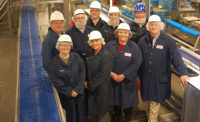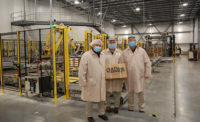Cover Story
Carcass-testing program puts Marcho Farms on the hunt for E. coli
To take its food-safety program to the next level, Marcho Farms replaced its traditional trim-testing program with an innovative, comprehensive carcass-testing program — a proactive tactic in the war against E. coli.

Rick Mesaris, QA/Food Safety manager; Bob Russell, general manager; and Brian Friesen, president of Marcho Farms Inc. at the company’s Harleysville, Pa., plant.

Rick Mesaris, QA/Food Safety manager for Marcho Farms, shows Andy Hanacek, editor-in-chief of The National Provisioner, the diagram of zones on the veal carcass that QA employees follow when taking carcass samples.

Marcho Farms QA employees take three N60 excision samples from each carcass in 10-head lots.

Marcho Farms QA employees then transfer the excision samples from each lot into a bag to send off for E. coli testing, the results of which the company receives within 24 hours.

Once the samples are taken, carcasses are bagged to prevent cross-contamination during the chilling process, should a carcass test positive for E. coli.

Once the samples are taken, carcasses are bagged to prevent cross-contamination during the chilling process, should a carcass test positive for E. coli.

After one lot is finished, the cycle starts over, and the next 10-head lot is brought in to be treated with an antimicrobial spray, then given 10 minutes to drip before its sample set is taken.







The phrase “continuous improvement” may not yet be cliché in the business world, but it’s teetering very close to the edge, as most companies like to discuss how — and believe that —they’re always looking to take the next step.
Reality often sets in for businesses when that next step threatens disruption to operations, financials or, in some cases, corporate status quo. As such, companies that do not fear change and truly practice continuous improvement cement their place as trailblazers.
In the meat industry, one might consider Wayne Marcho, founder of Marcho Farms, to be a trailblazer, as he has had a long history of investment into doing “what’s right” by the company and its consumers — the most recent evidence occurring when its continuous-improvement efforts were turned toward its already-strong food-safety record.
“We want to be a leader in food safety,” explains Brian Friesen, president of the Harleysville, Pa.-based veal processor. “We’ve had a history of performing extremely well, better than published averages, on our pathogen testing and felt we’re ready to push it up another notch.”
A bump toward this target came, in many ways, from the Food Safety and Inspection Service (FSIS) declaration in late 2011 that the “Big 6” non-O157 shiga-toxin producing E. coli serogroups (STECs) would be deemed adulterants. Soon afterward, Marcho Farms saw plenty of information on STECs available for beef processors, but little offered around handling these pathogens for veal processors. As a result, Marcho Farms reached out to Mohammad Koohmaraie, Ph.D., and his team at IEH Laboratories & Consulting Group for assistance.
Among the options discussed with Marcho Farms was a unique approach to pathogen testing that Dr. Mansour Samadpour of IEH Laboratories had developed and Koohmaraie encouraged the Marcho team to consider implementing. The procedures, which are patented by IEH Laboratories, had received a letter of no objection (LNO) from FSIS in 2012, but had yet to be put into a real-world plant. Marcho Farms would soon become that first facility.
Testing to improve
One of the reasons Marcho Farms has been successful in actually executing on its continuous-improvement initiatives is its small, long-tenured workforce. When the company embarks upon a mission, it includes the entire team of stakeholders from the processing floor on up through the executive management. With its food-safety strategies, Marcho Farms has acted no differently.
“Like everybody else, we were testing trim, and we began asking ourselves questions. How do we improve this?” Friesen says. “We know that, when contamination occurs, it happens on the kill floor, and we were in the position where we were killing on a Monday and not learning how the kill floor performed until Thursday morning. We were saying, ‘There’s got to be a better way than this.’”
Bob Russell, general manager at Marcho Farms, says the plant used trim testing to verify its sanitary dressing procedures, but even having a small kill floor team, it slowed the process of solving issues when they occurred.
“I can say the kill-floor team is very engaged in what we do,” he says. “But it’s difficult to go back and ask them, ‘Let’s see now, it’s Thursday morning, do you remember what we did differently on Monday?’”
Koohmaraie’s pathogen-testing proposal struck Russell as the innovative process the plant needed, the first piece of the puzzle for Marcho Farms to take that coveted next step.
“Koohmaraie’s team looked at beef trim differently than everybody else — they looked at the pitfalls of trim testing, did DNA testing inside a combo bin and found as many as 40 carcasses,” Russell explains. “So, there’s at least [12 categories of carcass quality and weight ranges] off the kill, and if you have a positive and try to find which one it was, it’s mission impossible. Even as small as we are and as slow as we run, it’s still difficult to go back and say exactly where the process failed.”
For Marcho Farms, however, its size mattered, making the transition simpler. The changes needed to adopt the carcass-testing process were not logistically difficult, says Rick Mesaris, QA/Food Safety manager for Marcho Farms. The plant needed to create a new work station directly in the carcass cooler, immediately after the final carcass-spray intervention, and had to develop a plan to ensure random testing and site selection on the carcasses.
“As far as manpower for collecting the carcass samples, we morphed those positions into it from the trim testing,” he adds. “And I think carcass testing is actually a little bit easier for them, because they don’t have to dig through a box looking for carcass surface: It’s right there in front of them.”
Testing to find
Once carcasses exit the blast cooler, they are sprayed with an antimicrobial intervention, and QA personnel give each lot a 10-minute drip time before taking samples. Marcho Farms groups carcasses in 10-head lots with excision samples taken from the surfaces of each and every carcass in three zones (top, middle and bottom), with the locations within each zone randomized by carcass. Lot samples are grouped together and sent off to the lab for testing. Meanwhile, after samples are taken from the carcass, another QA employee bags the entire carcass to help control shrink and prevent cross-contamination during the chill-and-hold process. Russell explains that the bagging of carcasses, which Marcho Farms had already been doing, helped when it came to getting approval from FSIS Risk and Innovations Management Division.
“They asked, ‘Now that you’re going to sample these carcasses, how are you going to keep them from cross-contaminating each other with a large cooler and a lot of head in there?’” he says. “It became very easy for us to say, ‘Where we bag now is important and critical to the process, but that’s what prevents cross-contamination.’”
Test results are known 12 to 14 hours after samples are submitted to the laboratory, and once they come back negative and the standard 48-hour chill time has passed, the lot is released and the veal is processed. Should a sample come back positive, the lot is bracketed and one carcass trailing and one leading is added, to expand the lot to 12 head. The entire lot is then isolated and put through a reconditioning process.
“We’re going to trim everything at an eighth of an inch on the entire carcass, and we retest all 12 head, individually — we take all 60 samples off each one,” Russell says. “All the negative carcasses go back into our process and are fabricated at the end of the shift. The trim from the 12 head go to cook regardless of the test results. If we get a positive, it will go to a safe end point, such as a cooker or a landfill.”
The carcass-testing procedures allow Marcho Farms to be even more proactive than it had been in the fight against pathogens. First, the carcass-testing procedures offer a more thorough sampling of the veal calves than trim testing ever did.
“A lot being a combo of trim or a pallet of boxes of trim represents about 50 calves,” Russell says. “With carcass testing, by taking samples from 10-head lots, we are collecting five times more samples while ensuring that 100 percent of the sample is carcass surface tissue.”
Additionally, Marcho Farms can perform far better root-cause identification. If carcass testing returns a positive result, the team can pinpoint where the contaminated carcasses were at various steps in the process and examine what happened on the kill floor at that specific time. It also can identify the farm where the veal was raised, using all this information to continually improve the process.
This is in stark contrast to trim testing, where results are not known for 72 hours and a large number of carcasses are represented by any positive results. With carcass testing, Marcho Farms can hunt for E. coli while simultaneously verifying its sanitary dressing procedures and solving any issues quickly.
“We’re not testing for negatives, we’re testing to find processing improvements,” Russell says. “Also, [with regard to cross-contamination of carcasses,] we don’t have to worry about the downstream processes. We’ve already tested and made sure all of the carcasses that we have moving forward have been found negative before they go into production, and it doesn’t interfere with anything in terms of business interruption at all because we get the results in 24 hours.”
Russell stresses the importance of getting feedback on procedural breakdowns to the kill floor quickly, and cites the carcass-testing as the most expedient way to do that.
“If you want to get your team engaged, give them information on what happened the day before — when you try and engage them on what happened four days ago, there’s not a lot of interest,” he says.
Testing to solve
Marcho Farms started carcass-testing validation in August 2014. The plant received an LNO for its carcass-testing procedure and began the process in March 2015. Through the first four months of the program, only two samples out of more than 2,100 taken came back positive. That’s not an indication of the effect of carcass testing insomuch as it is an indicator that Marcho Farms’ food-safety programs are succeeding overall, at least in comparison to industry averages.
Russell reaffirms, however, that the carcass-testing program isn’t set up to directly affect the number of positives that Marcho Farms sees. It’s a tool that can be used to solve issues by pinpointing and addressing them.
“That’s really what we’re trying to do with the whole process of carcass testing is to get back to root cause, identify what the exceptions are, and educate the entire team of what happened so that they understand the big picture,” he says. “The support of Wayne [Marcho] in all of this has allowed us to put tools in place. We now have video cameras, so that everybody who touches the hide, we observe what they are doing, do unbiased audits and give them daily feedback on how they’re following our sanitary dressing procedures.”
The specificity of the carcass-testing program is what helps the video-auditing system work efficiently, Friesen adds.
“Now that we’re testing in sequential order, if we get a positive, we can go back and identify that lot and watch them position by position all the way through the kill floor, to see any abnormality in the process,” he says.
Acceptance of the technology has been positive, says Herb Nicolo, plant manager, not only because the employees buy into the food-safety culture, but also because the company understands the potential pitfalls of repetitive-motion work.
“We’ve found that they work with such speed that they don’t always realize what they’ve done,” he explains. “It’s not a matter of them denying it or trying to cover it up; they don’t realize it until you show them the video.”
Testing to share
Undeniably, Marcho Farms benefits from a few factors that helped bring about quick adoption and early success for its carcass-testing procedures, which other processors might not be able or willing to endure. First, its size and the speed at which its line operates give it an advantage, says Russell.
“With veal, we have to have 48 hours of chill to get that good color, and beef blooms in 15 minutes when you open that carcass,” he says. “So our process opens up avenues for us to get this done without losing time or additional cost. Also, our exceptions are minimal here; I can count our missed attendance on one hand on Mondays, whereas in a big plant, those numbers are huge.”
Also in some larger plants, concerns over gathering accurate data could be a challenge. A successful carcass-testing program would only be as good as the carcass mapping (or, as Marcho Farms calls it: harvest monitoring) done on the front end.
“It’s crucial that they sample the areas they know to be the highest risk for potential [positives]. Those are the areas we want to cover,” Russell says. “And it’s by individual plants, not a big company saying that it’s going to change all its plants to this, and here’s the script.”
Meanwhile, Marcho Farms will move forward, faced with the challenge of continually validating its carcass-testing program while maintaining its top-of-the-line food-safety record.
“That’s a really critical piece: How do we improve validation of the process so that we can share more with the industry?” Russell says. “We’ve got to do things openly so that people understand it, and we invite folks that have questions or concerns to ask.”
Additionally, the company knows it’s not perfect on food safety and can do better at transferring less of a pathogen load from its live side to the kill floor, even if it has successful interventions in place. Carcass-testing combined with video auditing and the feedback it provides will provide Marcho Farms with additional improvement opportunities.
“It’s all about people and all about habits,” Russell says. “We can create better practices through what we have, and that’s the key to us dropping those loads and reducing our risk to where we’ve got total confidence that any exceptions are being caught in a normal manner.”
Friesen agrees and knows that Marcho Farms has the right group of people — hunting not only for E. coli and other pathogens, but also hunting for new trails to blaze on a continuous basis.
“We want to produce the safest product possible, and some of the key ingredients to make that happen are continuous improvement, constant vigilance and a strong team,” Friesen concludes. “I believe we have all those ingredients here.” NP
Looking for a reprint of this article?
From high-res PDFs to custom plaques, order your copy today!













